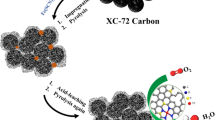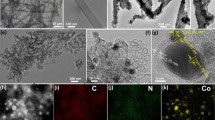Abstract
The development of high-performance, low-cost bifunctional catalysts with long-term stability for the oxygen reduction reaction (ORR) and oxygen evolution reaction (OER) is one of the most critical challenges for the large-scale application of metal–air batteries. Herein, we report an advanced nitrogen-doped mesoporous carbon (NMC) composite (NiCo2O4/CoNx–NMC) formed from a mixture of Co- and Ni-hydroxide-infiltrated phenolic resin and melamine resin. This composite exhibits superior electrocatalytic activity, stability, and selectivity for the ORR and OER. The activity parameter (ΔE), which is an indicator of the overall catalytic activity of bifunctional catalysts, was 0.76 V for NiCo2O4/CoNx–NMC. Therefore, catalyst outperforms the majority of previously reported non-precious metal-based bifunctional electrocatalysts. The remarkable ultra-high catalytic performance of NiCo2O4/CoNx–NMC for the ORR and OER can be attributed to the presence of different active sites of the CoNx structure and the formation of NiCo2O4 with the spinel structure, which was obtained by a stepwise pyrolysis process. This synthesis strategy opens a new avenue for the rational design of highly active bifunctional electrocatalysts.
Graphic abstract







Similar content being viewed by others
References
Zhu YP, Guo C, Zheng Y, Qiao SZ. Surface and interface engineering of noble-metal-free electrocatalysts for efficient energy conversion processes. Acc Chem Res. 2017;50(4):915.
Zhao S, Wang DW, Amal R, Dai L. Carbon-based metal-free catalysts for key reactions involved in energy conversion and storage. Adv Mater. 2019;31(9):e1801526.
Zhang M, Dai Q, Zheng H, Chen M, Dai L. Novel MOF-derived Co@N–C bifunctional catalysts for highly efficient zn–air batteries and water splitting. Adv Mater. 2018;30(10):1705431.
Chen M, Wang L, Yang H, Zhao S, Xu H, Wu G. Nanocarbon/oxide composite catalysts for bifunctional oxygen reduction and evolution in reversible alkaline fuel cells: a mini review. J Power Sources. 2018;375:277.
Fu J, Cano ZP, Park MG, Yu A, Fowler M, Chen Z. Electrically rechargeable zinc–air batteries: progress, challenges, and perspectives. Adv Mater 2017;29(7):1604685.
Shao M, Chang Q, Dodelet JP, Chenitz R. Recent advances in electrocatalysts for oxygen reduction reaction. Chem Rev. 2016;116(6):3594.
Sarapuu A, Kibena-Põldsepp E, Borghei M, Tammeveski K. Electrocatalysis of oxygen reduction on heteroatom-doped nanocarbons and transition metal–nitrogen–carbon catalysts for alkaline membrane fuel cells. J Mater Chem A. 2018;6(3):776.
Zhu C, Li H, Fu S, Du D, Lin Y. Highly efficient nonprecious metal catalysts towards oxygen reduction reaction based on three-dimensional porous carbon nanostructures. Chem Soc Rev. 2016;45(3):517.
Shen H, Gracia-Espino E, Wang L, Qin D, Gao S, Mamat X, Ren W, Wagberg T, Hu G. Microwave-assisted synthesis of multimetal oxygen-evolving catalysts. Electrochem Commun. 2017;81:116.
Wang F, Borodin O, Gao T, Fan X, Sun W, Han F, Faraone A, Dura JA, Xu K, Wang C. Highly reversible zinc metal anode for aqueous batteries. Nat Mater. 2018;17(6):543.
Jiang WJ, Gu L, Li L, Zhang Y, Zhang X, Zhang LJ, Wang JQ, Hu JS, Wei Z, Wan LJ. Understanding the high activity of Fe–N–C electrocatalysts in oxygen reduction: Fe/Fe3C nanoparticles boost the activity of Fe-N(x). J Am Chem Soc. 2016;138(10):3570.
Yang L, Zeng X, Wang W, Cao D. Recent progress in MOF-derived, heteroatom-doped porous carbons as highly efficient electrocatalysts for oxygen reduction reaction in fuel cells. Adv Funct Mater. 2018;28(7):1704537.
Ahn HS, Bard AJ. Surface interrogation scanning electrochemical microscopy of Ni(1−x)Fe(x)OOH (0 < x < 0.27) oxygen evolving catalyst: kinetics of the fast iron sites. J Am Chem Soc. 2016;138(1):313.
Fu G, Yan X, Chen Y, Xu L, Sun D, Lee JM, Tang Y. Boosting bifunctional oxygen electrocatalysis with 3D graphene aerogel-supported Ni/MnO particles. Adv Mater. 2018;30(5):1704609.
Shen H, Gracia-Espino E, Ma J, Tang H, Mamat X, Wagberg T, Hu G, Guo S. Atomically FeN2 moieties dispersed on mesoporous carbon: a new atomic catalyst for efficient oxygen reduction catalysis. Nano Energy. 2017;35:9.
Shen H, Gracia-Espino E, Ma J, Zang K, Luo J, Wang L, Gao S, Mamat X, Hu G, Wagberg T, Guo S. Synergistic effects between atomically dispersed Fe–N–C and C–S–C for the oxygen reduction reaction in acidic media. Angew Chem Int Ed Engl. 2017;56(44):13800.
Li J, Chen M, Cullen DA, Hwang S, Wang M, Li B, Liu K, Karakalos S, Lucero M, Zhang H, Lei C, Xu H, Sterbinsky GE, Feng Z, Su D, More KL, Wang G, Wang Z, Wu G. Atomically dispersed manganese catalysts for oxygen reduction in proton-exchange membrane fuel cells. Nat Catal. 2018;1(12):935.
Wang XX, Prabhakaran V, He Y, Shao Y, Wu G. Iron-free cathode catalysts for proton-exchange-membrane fuel cells: cobalt catalysts and the peroxide mitigation approach. Adv Mater. 2019;31(31):1805126.
Amiinu IS, Liu X, Pu Z, Li W, Li Q, Zhang J, Tang H, Zhang H, Mu S. From 3D ZIF nanocrystals to Co–Nx/C nanorod array electrocatalysts for ORR, OER, and Zn–air batteries. Adv Funct Mater. 2018;28(5):1704638.
Shang L, Yu H, Huang X, Bian T, Shi R, Zhao Y, Waterhouse GI, Wu LZ, Tung CH, Zhang T. Well-dispersed ZIF-derived Co, N–Co-doped carbon nanoframes through mesoporous-silica-protected calcination as efficient oxygen reduction electrocatalysts. Adv Mater. 2016;28(8):1668.
Tian Y, Xu L, Bao J, Qian J, Su H, Li H, Gu H, Yan C, Li H. Hollow cobalt oxide nanoparticles embedded in nitrogen-doped carbon nanosheets as an efficient bifunctional catalyst for Zn–air battery. J Energy Chem. 2019;33:59.
Chen YN, Guo Y, Cui H, Xie Z, Zhang X, Wei J, Zhou Z. Bifunctional electrocatalysts of MOF-derived Co–N/C on bamboo-like MnO nanowires for high-performance liquid- and solid-state Zn–air batteries. J Mater Chem A. 2018;6(20):9716.
Zhu C, Shi Q, Xu BZ, Fu S, Wan G, Yang C, Yao S, Song J, Zhou H, Du D, Beckman SP, Su D, Lin Y. Hierarchically porous M–N–C (M = Co and Fe) single-atom electrocatalysts with robust MNx active moieties enable enhanced ORR performance. Adv Energy Mater. 2018;8(29):1801956.
Li C, Wu M, Liu R. High-performance bifunctional oxygen electrocatalysts for zinc–air batteries over mesoporous Fe/Co–N–C nanofibers with embedding FeCo alloy nanoparticles. Appl Catal B. 2019;244:150.
Liu Y, Jiang H, Zhu Y, Yang X, Li C. Transition metals (Fe Co, and Ni) encapsulated in nitrogen-doped carbon nanotubes as bi-functional catalysts for oxygen electrode reactions. J Mater Chem A. 2016;4(5):1694.
Ma N, Jia Y, Yang X, She X, Zhang L, Peng Z, Yao X, Yang D. Seaweed biomass derived (Ni, Co)/CNT nanoaerogels: efficient bifunctional electrocatalysts for oxygen evolution and reduction reactions. J Mater Chem A. 2016;4(17):6376.
Yang J, Fujigaya T, Nakashima N. Decorating unoxidized-carbon nanotubes with homogeneous Ni-Co spinel nanocrystals show superior performance for oxygen evolution/reduction reactions. Sci Rep. 2017;7:45384.
Yan D, Li Y, Huo J, Chen R, Dai L, Wang S. Defect chemistry of nonprecious-metal electrocatalysts for oxygen reactions. Adv Mater. 2017;29(48):1606459.
Ren JT, Yuan GG, Weng CC, Yuan ZY. Rationally designed Co3O4–C nanowire arrays on Ni foam derived from metal organic framework as reversible oxygen evolution electrodes with enhanced performance for Zn–air batteries. ACS Sustain Chem Eng. 2017;6(1):707.
Gavrilov N, Momčilović M, Dobrota AS, Stanković DM, Jokić B, Babić B, Skorodumova NV, Mentus SV, Pašti IA. A study of ordered mesoporous carbon doped with Co and Ni as a catalyst of oxygen reduction reaction in both alkaline and acidic media. Surf Coat Technol. 2018;349:511.
Zou X, Huang X, Goswami A, Silva R, Sathe BR, Mikmekova E, Asefa T. Cobalt-embedded nitrogen-rich carbon nanotubes efficiently catalyze hydrogen evolution reaction at all pH values. Angew Chem Int Ed Engl. 2014;53(17):4461.
Zhou Z, Zhang Y, Chen P, Wu Y, Yang H, Ding H, Zhang Y, Wang Z, Du X, Liu N. Graphene oxide-modified zinc anode for rechargeable aqueous batteries. Chem Eng Sci. 2019;194:142.
Wan W, Liu X, Li H, Peng X, Xi D, Luo J. 3D carbon framework-supported CoNi nanoparticles as bifunctional oxygen electrocatalyst for rechargeable Zn–air batteries. Appl Catal B. 2019;240:193.
Mei H, Yang M, Shen Y, He F, Zhou Z, Chen X, Yang Y, Liu S, Zhang Y. Non-covalent pre-organization of molecular precursors: a facile approach for engineering structures and activities of pyrolyzed Co–N–C electrocatalysts. Carbon. 2019;144:312.
Huang J, Zhang B, Xie YY, Lye WWK, Xu ZL, Abouali S, Akbari-Garakani M, Huang JQ, Zhang TY, Huang B, Kim JK. Electrospun graphitic carbon nanofibers with in situ encapsulated Co–Ni nanoparticles as freestanding electrodes for Li–O2 batteries. Carbon. 2016;100:329.
Li Z, Yang J, Agyeman DA, Park M, Tamakloe W, Yamauchi Y, Kang YM. CNT@Ni@Ni–Co silicate core–shell nanocomposite: a synergistic triple-coaxial catalyst for enhancing catalytic activity and controlling side products for Li–O2 batteries. J Mater Chem A. 2018;6(22):10447.
Zhang Z, Sun J, Wang F, Dai L. Efficient oxygen reduction reaction (ORR) catalysts based on single iron atoms dispersed on a hierarchically structured porous carbon framework. Angew Chem Int Ed Engl. 2018;57(29):9038.
Spori C, Kwan JTH, Bonakdarpour A, Wilkinson DP, Strasser P. The stability challenges of oxygen evolving catalysts: towards a common fundamental understanding and mitigation of catalyst degradation. Angew Chem Int Ed Engl. 2017;56(22):5994.
Hunter BM, Gray HB, Muller AM. Earth-abundant heterogeneous water oxidation catalysts. Chem Rev. 2016;116(22):14120.
Liu X, Xi W, Li C, Li X, Shi J, Shen Y, He J, Zhang L, Xie L, Sun X, Wang P, Luo J, Liu LM, Ding Y. Nanoporous Zn-doped Co3O4 sheets with single-unit-cell-wide lateral surfaces for efficient oxygen evolution and water splitting. Nano Energy. 2018;44:371.
Dou S, Tao L, Huo J, Wang S, Dai L. Etched and doped Co9S8/graphene hybrid for oxygen electrocatalysis. Energy Environ Sci. 2016;9(4):1320.
Pei Z, Li H, Huang Y, Xue Q, Huang Y, Zhu M, Wang Z, Zhi C. Texturing in situ: N, S-enriched hierarchically porous carbon as a highly active reversible oxygen electrocatalyst. Energy Environ Sci. 2017;10(3):742.
Li Y, Zhong C, Liu J, Zeng X, Qu S, Han X, Deng Y, Hu W, Lu J. Atomically thin mesoporous Co3O4 layers strongly coupled with N-rGO nanosheets as high-performance bifunctional catalysts for 1D knittable zinc–air batteries. Adv Mater. 2018;30(4):1703657.
Acknowledgements
This work was financially supported by the National Natural Science Foundation of China (No. 21677171) and the West Light Foundation of Chinese Academy of Sciences (No. 2016-YJRC-1).
Author information
Authors and Affiliations
Corresponding authors
Electronic supplementary material
Below is the link to the electronic supplementary material.
Rights and permissions
About this article
Cite this article
Qiao, MF., Wang, Y., Li, L. et al. Self-templated nitrogen-doped mesoporous carbon decorated with double transition-metal active sites for enhanced oxygen electrode catalysis. Rare Met. 39, 824–833 (2020). https://doi.org/10.1007/s12598-019-01345-9
Received:
Revised:
Accepted:
Published:
Issue Date:
DOI: https://doi.org/10.1007/s12598-019-01345-9




